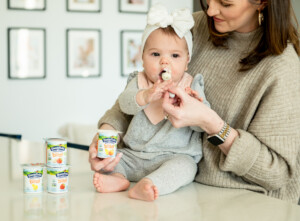That first roll over . . . for many babies, it is the first big developmental milestone. It’s the first thing to write in the baby book and the first time parents witness their baby taking control of his body. Did you know that countless mini-milestones lead to this momentous event?
Around Four Months
Babies typically roll front to back around two to four months, front to side around four to five months, and front to back around five and a half to six months. However, as in all early development, the timing of the first roll over can be highly variable.
Of course, there are the fluke roll overs. These happen accidentally because baby shifts her weight a certain way while in a certain position, or a reflex kicks in at the right time to make it happen. These early roll overs are usually involuntary and unexpected and often don’t happen again until closer to four months. As a pediatric occupational therapist working in the Neonatal Intensive Care Unit, I see newborn babies roll over once in a while. I recently witnessed a roll over from a three-week-old-baby who was trying to fidget around a little bit, and suddenly she flipped on her back, right up against the window of the incubator.
You may have a baby who experiences these little accidental roll overs from time to time but then begins to do it on purpose closer to four months. We differentiate these accidental roll overs from purposeful roll overs because purposeful roll overs take a whole different set of skills. Let’s take a closer look at the mini-milestones that lay the groundwork over the first few months of your baby’s life.
Milestones Leading to the First Intentional Baby Roll Over
The first thing we look for in newborns’ physical development is their ability to hold their head up against gravity. Parents are usually surprised at how well newborns can hold their heads up for short periods. Babies are typically born with enough strength in their neck muscles to lift their heads and look around for a few seconds. When placed on their tummy, babies can usually turn their heads to one side or the other and clear their airway so their face is not down in the blanket.
The second mini-milestone that contributes to the skill of rolling over is mini push-ups. When babies are lying in tummy time, they will begin to push their upper body up and lift their head to a 45 or 90-degree angle. These mini push-ups develop strength through baby’s shoulders and upper body and create segmentation between their upper and lower body. Upper body strength and the ability to activate the upper body’s muscles are important in rolling over.
Around the same time, babies will start to develop an awareness and curiosity about the world around them. As babies’ vision comes into focus and they can see objects and people across the room and visually focus and track, they are more interactive and interested. This interest in their little world contributes to the purposeful roll-over, as babies often roll to get a better view of something or get closer to a toy that interests them. You can consider this new visual skill as a mini-milestone along the road to the first roll.
6 Ways to Encourage Your Baby to Roll Over
- Provide your baby lots of tummy time starting right at birth. You can start with five minutes a few times a day and build up to 20 minutes a few times per day by three months.
- Allow your baby to look at visually stimulating toys and objects. Hold the object eight to ten inches from your baby’s face while lying on her back (that is the distance that she can best process vision). Move the object in an arc in front of your baby’s face encouraging her to track the item left and right. As she turns her head, see if she turns her body as well.
- Hold your baby upright while snuggling. When in a baby carrier, hold against your body to help your baby develop trunk strength.
- Allow your baby to play while lying on her left or right side while you supervise her.
- Limit the time your baby spends in carriers, swings, car seats, and strollers, so he gets a lot of movement and practices the skills necessary for rolling.
- You can help your baby feel what it feels like to roll over by laying her on her belly on a blanket, then gently lift one side of the blanket and slowly keep lifting it until you are lifting the part of the blanket that is under your baby. The blanket causes her to roll onto her side. Go very slowly and see if she helps after she feels her body begin to lift.
The first roll over is sometimes opening the flood gates to constant movement! Gone are the days when you place your baby down and come back later and find her in the same spot!













